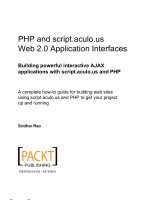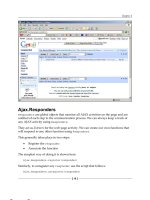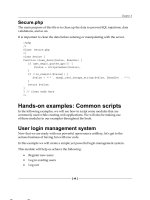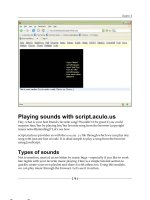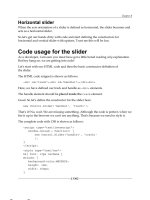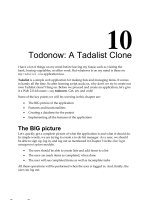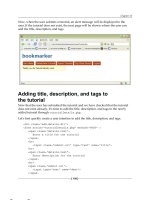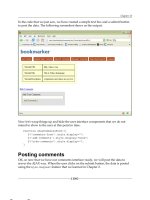rss and atom in action web 2.0 building blocks
Bạn đang xem bản rút gọn của tài liệu. Xem và tải ngay bản đầy đủ của tài liệu tại đây (11.99 MB, 397 trang )
RSS and Atom in Action
RSS and Atom
in Action
WEB 2.0 BUILDING BLOCKS
DAVE JOHNSON
MANNING
Greenwich
(74° w. long.)
For online information and ordering of this and other Manning books, go to
www.manning.com. The publisher offers discounts on this book when ordered in quantity.
For more information, please contact:
Special Sales Department
Manning Publications Co.
209 Bruce Park Avenue Fax: (203) 661-9018
Greenwich, CT 06830 email:
©2006 by Manning Publications Co. All rights reserved.
No part of this publication may be reproduced, stored in a retrieval system, or transmitted,
in any form or by means electronic, mechanical, photocopying, or otherwise, without
prior written permission of the publisher.
Many of the designations used by manufacturers and sellers to distinguish their products
are claimed as trademarks. Where those designations appear in the book, and Manning
Publications was aware of a trademark claim, the designations have been printed in initial
caps or all caps.
Recognizing the importance of preserving what has been written, it is Manning’s policy
to have the books they publish printed on acid-free paper, and we exert our best efforts
to that end.
Manning Publications Co. Copyeditor: Jody Gilbert
209 Bruce Park Avenue Typesetter: Denis Dalinnik
Greenwich, CT 06830 Cover designer: Leslie Haimes
ISBN 1932394494
Printed in the United States of America
1 2 3 4 5 6 7 8 9 10 – VHG – 10 09 08 07 06
To Andi, Alex, Linus, and Leo
vii
PART 1 PROGRAMMING THE WRITABLE WEB 1
0
■
What you need to know first 3
1
■
New ways of collaborating 16
2
■
Development kick-start 28
3
■
Under the hood 40
4
■
Newsfeed formats 56
5
■
How to parse newsfeeds 79
6
■
The Windows RSS Platform 109
7
■
The ROME newsfeed utilities 140
8
■
How to serve newsfeeds 177
9
■
Publishing with XML-RPC based APIs 206
10
■
Publishing with Atom 227
brief contents
viii BRIEF CONTENTS
PART 2 BLOG APPS 247
11
■
Creating a group blog via aggregation 249
12
■
Searching and monitoring the Web 261
13
■
Keeping your blog in sync 278
14
■
Blog by sending email 286
15
■
Sending a daily blog digest by email 292
16
■
Blog your software build process 299
17
■
Blog from a chat room 309
18
■
Distribute files podcast style 320
19
■
Automatically download podcasts 333
20
■
Automatically validate newsfeeds 340
21
■
The best of the rest 347
ix
foreword xix
preface xxi
acknowledgments xxiii
about this book xxiv
PART 1 PROGRAMMING THE WRITABLE WEB 1
0
What you need to know first 3
0.1 What you need to know about Java or C# 4
0.2 What you need to know about web development 5
Web services 5
■
Java web development 5
■
C# web
development 5
■
Running scheduled tasks 6
0.3 What you need to know about XML 6
Java XML tools 6
■
C# XML tools 6
0.4 Blog technology terminology 7
0.5 The components we’ll use 8
Blog application building blocks 8
0.6 Organization of the book 10
0.7 The Blogapps examples 14
0.8 Summary 15
contents
x CONTENTS
1
New ways of collaborating 16
1.1 Research blogging 17
1.2 Status blogging 20
1.3 Build blogging 21
1.4 Blogging the business 22
1.5 Nina’s and Rangu’s grand plan 25
1.6 Summary 27
2
Development kick-start 28
2.1 Blog server setup 29
2.2 The Blog Poster example 31
Invoking Blog Poster 32
2.3 Blog Poster for Java 32
Running Blog Poster for Java 35
2.4 Blog Poster for C# 35
Running Blog Poster for C# 38
2.5 Summary 39
3
Under the hood 40
3.1 Anatomy of a blog server 41
Blog server data model 42
■
Anatomy of a
blog entry 43
■
Users, privileges, and
group blogs 45
■
Blog server architecture 46
3.2 Anatomy of a wiki server 49
Wiki server data model 49
■
Wiki server
architecture 51
3.3 Choosing a blog or wiki server 52
Narrowing your choices 52
■
Comparing
blog and wiki servers 53
3.4 Summary 55
CONTENTS xi
4
Newsfeed formats 56
4.1 The birth of RSS 57
RSS 0.91 57
■
The elements of RSS 0.91 59
4.2 The RDF fork: RSS 1.0 61
The elements of RSS 1.0 62
■
Extending RSS
1.0 with modules 63
4.3 The simple fork: RSS 2.0 65
The elements of RSS 2.0 65
■
Enclosures and
podcasting 67
■
Extending RSS 2.0 67
4.4 The nine incompatible versions of RSS 68
4.5 The new standard: Atom 70
Atom by example 70
■
Atom common
constructs 71
■
The elements of Atom 73
Atom identifiers 74
■
The Atom content
model 75
■
Podcasting with Atom 76
4.6 Summary 77
5
How to parse newsfeeds 79
5.1 The possibilities 80
5.2 Parsing with an
XML parser 81
Parsing RSS 1.0 81
■
Parsing RSS 2.0 83
Parsing Atom 86
5.3 Parsing with a newsfeed library 91
The Universal Feed Parser for Python 91
The ROME newsfeed utilities 92
■
Jakarta
Feed Parser for Java 93
■
The Windows
RSS Platform 95
5.4 Developing a newsfeed parser 97
AnyFeedParser for Java 98
5.5 Fetching newsfeeds efficiently 104
HTTP conditional GET 104
■
Other techniques 106
5.6 Summary 108
xii CONTENTS
6
The Windows RSS Platform 109
6.1 Windows RSS Platform overview 110
Browse, search, and subscribe with IE7 111
Components of the Windows RSS Platform 113
6.2 Managing subscriptions with the Common
Feed List 117
Getting started with the Common Feed List 117
Creating subscriptions 120
■
Monitoring events 121
6.3 Parsing newsfeeds with the Feeds API 124
A simple newsfeed parsing example 125
Parsing extension elements and funky RSS 126
6.4 Windows RSS Platform newsfeed extensions 130
Common Feed (CF) extensions 131
■
Simple
List Extensions (SLE) 134
■
Simple Sharing
Extensions (SSE) 136
6.5 Summary 139
7
The ROME newsfeed utilities 140
7.1 Introducing ROME 141
How ROME works 142
■
ROME limitations 146
The ROME subprojects 146
7.2 Parsing newsfeeds with ROME 148
Parsing to the SyndFeed model 148
■
Parsing
funky RSS 150
■
Parsing to the RSS model 152
Parsing to the Atom model 154
7.3 Fetching newsfeeds with ROME 158
How the ROME Fetcher works 158
Using the ROME Fetcher 159
7.4 Generating newsfeeds with ROME 161
7.5 Extending
ROME 163
The ROME plug-in architecture 164
Adding new modules to ROME 166
Overriding ROME 171
7.6 Summary 176
CONTENTS xiii
8
How to serve newsfeeds 177
8.1 The possibilities 178
8.2 The basics 179
Which newsfeed formats to support? 179
■
How to
indicate newsfeeds are available? 179
■
Static or
dynamic? 181
■
Which generator? 182
■
Ensuring
well-formed XML 182
■
Validating newsfeeds 183
8.3 File Depot examples 185
8.4 Generating newsfeeds with Java 186
Implementing the File Depot in Java 186
Generating the File Depot newsfeed in Java 187
Serving the File Depot newsfeed in Java 190
8.5 Generating newsfeeds with C# 192
Implementing the File Depot in C# 193
Generating the File Depot newsfeed in C# 193
Serving the File Depot newsfeed with C# 196
8.6 Serving newsfeeds efficiently 197
Server-side caching 197
■
Web proxy
caching 198
■
Client-side caching 199
Compression 199
■
Caching and compression
in a Java web application 199
■
Caching and
compression in a C# Web application 202
8.7 Summary 205
9
Publishing with XML-RPC based APIs 206
9.1 Why XML-RPC? 207
Making a method call 207
9.2 The Blogger API 210
9.3 The MetaWeblog
API 211
The same metadata as RSS 211
■
Six new methods
that complement the Blogger API 212
9.4 Building a blog client with C# and XML-RPC 213
Why a blog client library? 213
■
Three blog client
library interfaces 214
■
Implementing the blog client
library in C# 217
xiv CONTENTS
9.5 Using the blog client library 224
9.6 Summary 225
10
Publishing with Atom 227
10.1 Why Atom? 228
Why not XML-RPC or SOAP? 228
10.2 How Atom protocol works 229
Discovery and collections 229
■
Atom protocol
from the command line 230
■
Discovering Atom
resources and services 231
■
Posting and updating blog
entries 235
■
Posting and updating media files 238
10.3 Building a blog client with Atom protocol 240
Atom does more 240
■
Expanding the blog client
interfaces 242
■
Atom blog client implementation 244
Atom blog client in action 245
10.4 Summary 246
PART 2 BLOG APPS 247
11
Creating a group blog via aggregation 249
11.1 Introducing Planet Tool 250
11.2 Configuring Planet Tool 251
11.3 Creating templates for Planet Tool 253
11.4 Running Planet Tool 256
11.5 Planet Tool object reference 256
11.6 Under the hood 259
11.7 Summary 260
12
Searching and monitoring the Web 261
12.1 Technorati.com: Conversation search engine 262
Subscribing to Technorati watchlists 264
Monitoring tags with Technorati 264
CONTENTS xv
12.2 The Technorati API 265
Getting a Technorati API key 266
Calling the Technorati API 266
12.3 Other blog search services 271
12.4 Open Search: The future of search? 274
Open Search description format 274
Open Search result elements 275
Why Open Search? 276
12.5 Summary 276
13
Keeping your blog in sync 278
13.1 Designing Cross Poster for C# 279
Design limitations 280
13.2 Configuring Cross Poster for C# 280
13.3 The code for Cross Poster for
C# 281
13.4 Running Cross Poster for
C# and Java 285
13.5 Summary 285
14
Blog by sending email 286
14.1 Designing Mail Blogger for C# 287
14.2 Configuring Mail Blogger for
C# 287
14.3 The code for Mail Blogger for
C# 288
14.4 Running Mail Blogger for
C# and Java 291
14.5 Summary 291
15
Sending a daily blog digest by email 292
15.1 Designing Blog Digest for C# 293
Design limitations 293
15.2 Configuring Blog Digest for C# 293
15.3 The code for Blog Digest for
C# 294
15.4 Running Blog Digest for
C# and Java 298
15.5 Summary 298
xvi CONTENTS
16
Blog your software build process 299
16.1 Blogging from Ant 300
Base blog task 301
■
Post blog entry task 304
Post blog resource task 306
16.2 Summary 308
17
Blog from a chat room 309
17.1 A wiki-blogging chatbot 310
Chat Blogger design 310
■
Chat Blogger
guidelines 311
■
Chat Blogger configuration 312
Chat Blogger construction 313
■
Chat Blogger
implementation 314
■
Running Chat Blogger 318
17.2 Summary 319
18
Distribute files podcast style 320
18.1 Designing FileCaster 321
The podcast server 322
18.2 Implementing FileCaster 323
18.3 FileCaster upload page 325
18.4 FileCaster newsfeed 330
18.5 Running FileCaster 332
18.6 Room for improvement 332
18.7 Summary 332
19
Automatically download podcasts 333
19.1 Designing FileCatcher 334
19.2 Implementing FileCatcher 335
19.3 Running FileCatcher for
C# 338
19.4 Summary 339
CONTENTS xvii
20
Automatically validate newsfeeds 340
20.1 Getting started 341
Setting up Python 341
■
Setting up Feed Validator 341
20.2 Implementing auto-validator 342
20.3 Running auto-validator 344
Using Windows Scheduled Tasks 345
Using UNIX cron 346
20.4 Summary 346
21
The best of the rest 347
21.1 Monitor anything 348
Monitor the weather 348
■
Shop with your
newsfeed reader 349
■
Use newsfeeds to monitor
eBay auctions 350
■
Monitor upcoming events
via calendar newsfeeds 350
■
Turn mailing lists
into newsfeeds 351
21.2 Syndicate everything 351
Syndicate operating system and network events 352
Syndicate vehicle status 352
■
Syndicate your logs 352
21.3 Tag the Web 353
Create a tagged link blog with del.icio.us 353
Create a tagged photo blog with Flickr.com 353
Tag your blog entries with Technorati Tags 354
Geotag the Web 354
21.4 Aggregate yourself 355
Create an aggregated blog with Planet Tool 355
Mix your own newsfeeds with Feedburner.com 356
21.5 Get the word out 356
Bring your bloggers together with aggregation 356
Bring bloggers together with tagging 356
Track news and blogs to find the conversations 357
xviii CONTENTS
21.6 Open up your web site 357
Open up your site with newsfeeds, protocols, and tagging 357
Syndicate your search results with A9 Open Search 357
21.7 Build your own intranet blogosphere 358
Unite internal communities with aggregation 358
Build a folksonomy of your intranet 358
21.8 Blog your software project 358
Use newsfeeds to syndicate source code changes 359
Pull software documentation from a wiki 359
21.9 Summary 360
index 361
xix
foreword
Ever since Henry Ford told his customers they could have “any color so long
as it’s black,” our consumer society has been driven by the vision and goals of
just a few creators. But in the 1990s, the emergence of the worldwide Web led
to the explosive popularization of the Internet, and it became clear that the
one-way flow of ideas upon which the consumer society was based would soon
be a memory. The ubiquity of the Internet is now thrusting us headlong into a
new age, where the flow of ideas changes from one-way to many-way, and the
key to society becomes participation instead of just consumption.
It was in that context that a few colleagues and I started the web site
blogs.sun.com for Sun Microsystems. We could see that in a “participation
age,” a key to the company’s success would be providing the means for Sun’s
staff to directly engage with the technology and customer communities in
which they were participating. All over the world, in every corner of human
interest, others have been coming to the same conclusion, and today blogs are
proliferating as fast as web sites did in the early 1990s.
With these blogs, almost incidentally, comes another technology that may
have an even greater effect on society: the syndication feed, a computer-
readable list of blog contents. Used today by blog reader programs and by
aggregators (such as the BlogLines
1
web site or the Planet Roller
2
aggregator,
1
2
xx FOREWORD
with which I build my summary blog “The Daily Mink”
3
), syndication feeds
allow innovative repurposing of the content of blogs and open up new avenues
for content sharing, such as podcasting. Although use of syndication feeds is in
its infancy, I predict big things, as the ability to create and consume them gets
built into the operating systems we use on computers and mobile devices.
It may seem simple, but the syndication feed, in whatever format it’s found—
RSS or Atom—is an important step in the evolution of the system at the heart of
the Web,
XML. The original authors of XML saw it as a universal document lan-
guage, allowing a tree-structured representation of a document. Syndication
feeds bring another powerful structure to
XML—lists and collections.
Lists and collections (such as databases) are at the core of so much of comput-
ing already, and syndication feeds provide a means for programs to share data
organically. They provide an avenue for easy
SOA (service-oriented architectures)
and unlock imaginative use of all the data that swirls around us—bank accounts,
health records, billing information, travel histories, and so much more. Syndica-
tion feeds make the Web programmable. More than that, Atom standardizes the
means by which feeds are accessed, providing an
API to decouple the web site
from the program that exploits its feeds.
A wave of people, the “Web 2.0” movement, is already using syndication feeds
and Ajax to create web sites such as Flickr, del.icio.us, Bloglines, and Technorati,
and they’re just scratching the surface of what’s possible.
This book is an important reference for people who want to be ready for the
future. You may have picked it up for information about the technology side of
blogging, but it offers much more than that. It’s a launch pad for the future. Pio-
neers like Tim Bray, Sam Ruby, Dave Winer, and Mark Pilgrim had to make all
this up as they went along.
For you, there’s this book. The skills it teaches you may prove to be the key
that unlocks a participation-age program that will change the world. Read on,
program wisely, and create the future!
S
IMON PHIPPS
Chief Open Source Officer
Sun Microsystems, Inc.
3
xxi
preface
Whether you consider the first blogs to be the online journals started around
the time Jorn Barger coined the term “weblog” in 1997, or the “what’s new”
pages at
NCSA and Netscape shortly after the birth of the Web, or the politi-
cal pamphlets of American Revolutionary War times, you have to acknowl-
edge that the concept of blogging is not entirely new. Blogging is just another
word for writing online.
What is new is the widespread adoption of blog technology—newsfeeds and
publishing protocols—on the Web. In the late 1990s, blog software and web
portal developers needed standard data formats to make it easy to syndicate
content on the Web. Thus,
RSS, Atom, and other XML newsfeed formats were
born. They needed standard protocols for publishing to and programming
the Web. Thus,
XML-RPC, SOAP, and web services were born.
Now, thanks to the explosion of interest in blogging, podcasting, and
wikis, those same developer-friendly blog technologies are everywhere. News-
feeds are a standard feature of not just blogs, but also of web sites, search
engines, and wikis everywhere. Computers, music players, and mobile devices
are tied in, too, as newsfeed technologies become a standard part of browsers,
office applications, and operating systems. Even if you don’t see opportunities
for innovation here, your users are going to ask for these technologies, and
now’s the time to prepare.
xxii PREFACE
This book is about building applications with those blog technologies. For
the sake of the cynical developers in the audience, we start with a few use sto-
ries that show some truly new ways of collaborating using blog technology.
Then, we explain what you need to know about blog technology—and not just
RSS and Atom. We also cover blog server architecture, blogging APIs, and web
services protocols.
To help you get started, we’ve included what amounts to a blog technology
developer’s kit, including a complete blog server, newsfeed parsers, a blog client
library and, in part 2, ten immediately useful blog applications, or blog apps, writ-
ten in Java and
C#. The blog server and the ten applications, known as the
Blogapps server and Blogapps examples, are both maintained as an open source
project at , where you’re welcome to help maintain
and improve them.
I hope we’ve provided everything you need to start building great blog appli-
cations, and I look forward to seeing what you build. Enjoy!
xxiii
acknowledgments
There’s only one name on the cover, but a host of people helped out with the
book and they all deserve my thanks.
I’ll start with Rick Ross, who encouraged me to write and who introduced me
to Manning Publications and publisher Marjan Bace. Manning was a joy to
work with, thanks to Denis Dalinnik, Jody Gilbert, Mike Levin, Dottie Marsico,
Sharon Mullins, Frank Blackwell, Mary Piergies, Karen Tegtmeyer, Helen Trimes
and the rest of the crew.
Thanks also to reviewers Tim Bray, Simon Brown, Steven Citron-Pousty, Rick
Evans, Jack Herrington, Frank Jania, Lance Lavandowska, Robert McGovern,
John Mitchell, Jaap van der Molen, Yoav Shapira, Doug Warren, Henri Yandell,
Peter George, Paul Kedrosky, Joe Rainsberger, Pim Van Heuven, Patrick Chan-
ezon, Alejandro Abdelnur, and Walter Von Koch who all provided invaluable
feedback in the early reviews of the book. And special thanks to Mike Levin who
was the technical proofreader of the final manuscript.
Thanks to Simon Phipps, who wrote the foreword and who was brave
enough to use the book’s software to run his personal web site. And thanks to
Masood Mortazavi, who provided the text about “Value at Risk” in the first
screen shot that appears in chapter 1.
Once again, I have to thank my family, who are happier than anybody that
the book is finally finished.
xxiv
about this book
This book shows developers how to build applications using blog technolo-
gies. Part 1 explains the fundamentals of blog technology, including blog and
wiki server architecture,
RSS and Atom newsfeed formats, the MetaWeblog
API, and the Atom protocol. Once we have the fundamentals out of the way,
we focus on building applications. Each chapter in part 2 is devoted to one
immediately useful blog application.
You will find a more detailed roadmap and introduction to the book in
chapter 0, “What you need to know first.”
Who should read this book
This book is intended for developers and IT innovators who need to under-
stand blog, wiki, and newsfeed technologies. If you’d like to add newsfeed-
reading capabilities to your applications or newsfeed-generation capabilities
to your web sites, this is the book for you. If you’d like to automate the process
of publishing to the Web, you’ll find this book very useful. If you’ve been asked
to deploy blog and wiki technologies and want to understand blog and wiki
server architecture before selecting software, you’ll find the answers you need
here. And if you’re just looking for new ideas and opportunities, you’ll find a
wealth of those here as well.
For most of the chapters, we assume that you understand web development
with Java or
C#. For more information about the prerequisites of the book and
